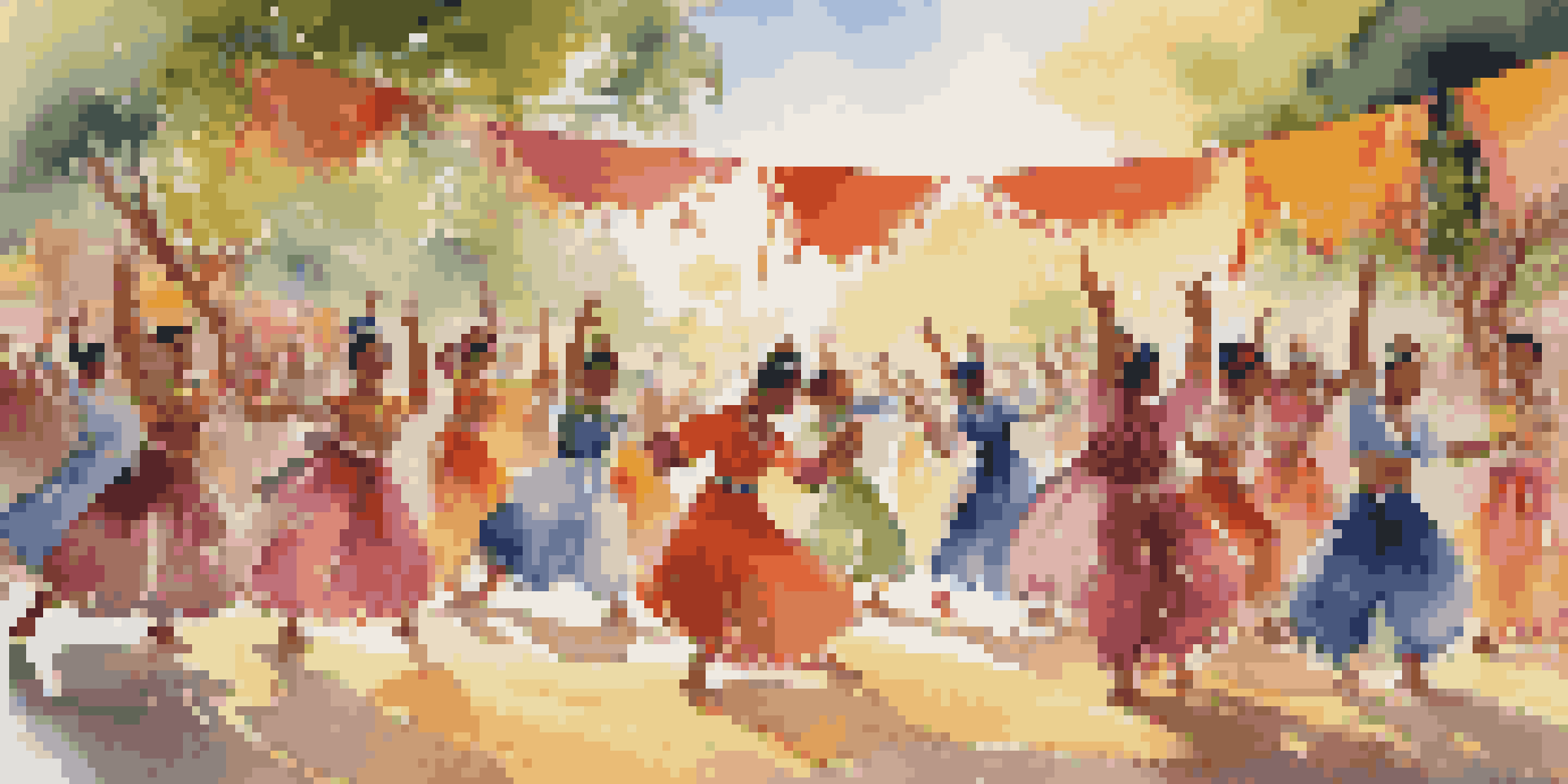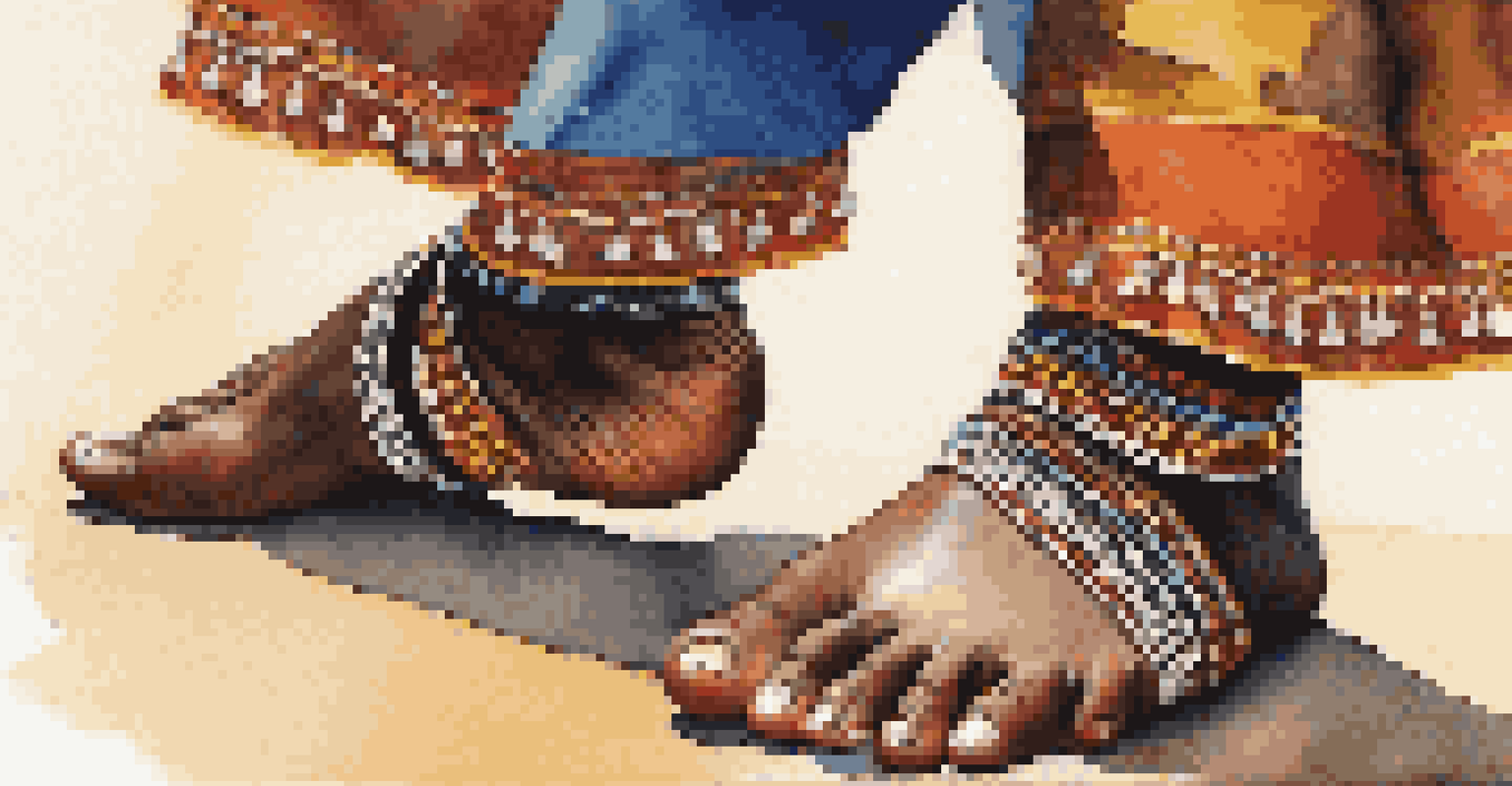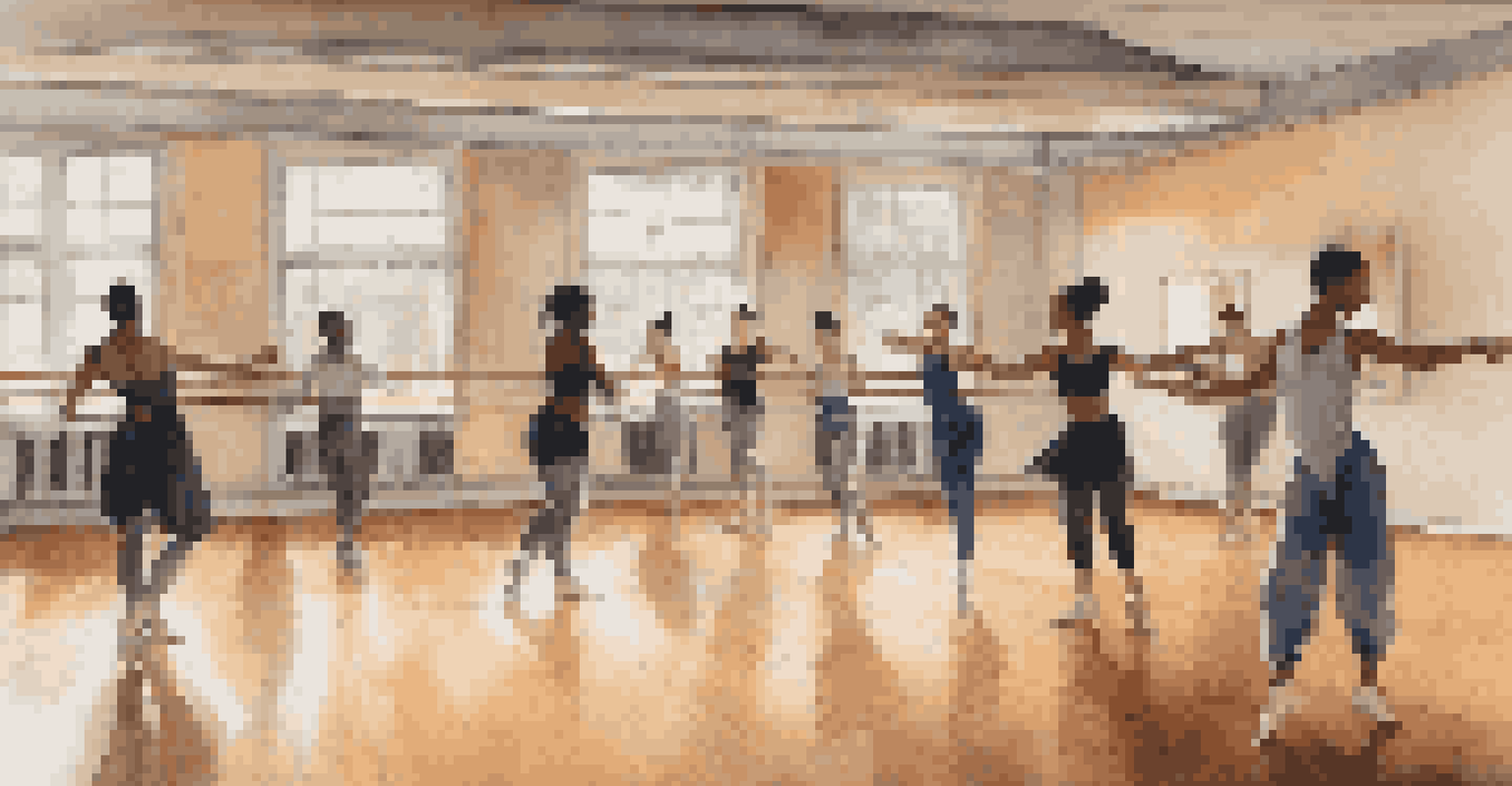The Influence of Cultural Heritage in Dance Collaborations

Understanding Cultural Heritage in Dance
Cultural heritage refers to the traditions, customs, and values passed down through generations. In the realm of dance, this heritage acts as a vibrant source of inspiration, influencing movements, styles, and themes. By embracing their unique cultural backgrounds, dancers can create works that resonate deeply with audiences, adding layers of meaning and context.
Dance is the hidden language of the soul.
For example, traditional African dance often incorporates storytelling through movement, expressing the rich history and experiences of the community. Similarly, Indian classical dance forms like Bharatanatyam showcase intricate footwork and hand gestures that convey specific narratives. This connection between dance and cultural heritage not only preserves history but also fosters a sense of identity.
Moreover, understanding cultural heritage in dance encourages respect and appreciation for diversity. It opens up opportunities for cross-cultural collaborations, allowing artists to learn from each other and create innovative performances that reflect a blend of styles. Thus, cultural heritage is not just a backdrop; it is a vital aspect that shapes the very essence of dance.
The Role of Collaboration in Dance
Collaboration in dance is akin to a harmonious orchestra, where each dancer contributes their unique voice to create a unified performance. When artists from different cultural backgrounds come together, they bring a wealth of perspectives and techniques that can elevate the art form. This collective creativity often leads to groundbreaking works that challenge traditional norms.

Take, for instance, the collaboration between hip-hop dancers and ballet performers. By merging the athleticism of hip-hop with the grace of ballet, dancers can explore new narratives and movement vocabularies. Such collaborations not only expand the artistic boundaries but also attract diverse audiences, fostering a richer appreciation for dance as a whole.
Cultural Heritage Enriches Dance
Cultural heritage provides dancers with inspiration and context, allowing them to create meaningful works that resonate with audiences.
Additionally, these partnerships can serve as a platform for dialogue about cultural exchange and understanding. As dancers share their stories and traditions, they build bridges between communities, ultimately enriching the cultural landscape. Collaboration is a powerful tool that transforms individual expression into a collective experience.
Cultural Exchange Through Dance Festivals
Dance festivals play a pivotal role in promoting cultural exchange and showcasing diverse traditions. These events provide a stage for performers from various backgrounds to share their art, fostering an environment of learning and appreciation. Audiences are treated to a rich tapestry of dance styles, each telling its own story rooted in cultural heritage.
The dance is a poem of which each movement is a word.
For example, festivals like the Edinburgh International Festival or the Jacob's Pillow Dance Festival feature artists from around the globe, presenting everything from traditional folk dances to contemporary interpretations. This exposure not only entertains but also educates viewers about the significance of each dance form, cultivating a deeper understanding of cultural nuances.
Moreover, these festivals often encourage interaction among artists, leading to spontaneous collaborations and cross-pollination of ideas. Such exchanges can spark creativity and innovation, resulting in unique performances that celebrate cultural diversity. In this way, dance festivals become vital spaces for cultural dialogue and artistic growth.
Challenges in Cultural Dance Collaborations
While cultural collaborations in dance can be immensely rewarding, they also come with their share of challenges. One significant issue is the risk of cultural appropriation, where elements of a culture are borrowed without proper understanding or respect. This can lead to misrepresentation and exploitation, which ultimately undermines the original cultural significance.
For instance, when traditional dance movements are stripped of their context and used in a commercial setting, it can dilute their meaning and offend the communities they originate from. It's essential for dancers to approach collaborations with sensitivity and a willingness to learn, ensuring that they honor the cultures they are engaging with.
Collaboration Fuels Innovation
Collaborations between dancers from diverse backgrounds lead to groundbreaking performances that challenge traditional norms and foster cultural exchange.
Additionally, logistical challenges such as language barriers and differing artistic visions can complicate the collaboration process. Successful partnerships require open communication, mutual respect, and a shared commitment to creating something meaningful. Navigating these challenges can strengthen the collaborative relationship and lead to authentic artistic expressions.
The Impact of Technology on Dance Collaborations
Technology has revolutionized the way dance collaborations are formed and executed. With tools like video conferencing and social media, dancers can connect across the globe, sharing ideas and techniques in real-time. This ease of communication has broken down geographical barriers, allowing for a more inclusive approach to dance creation.
For example, choreographers can collaborate with dancers from different countries, developing pieces that fuse various cultural influences without ever being in the same room. Online platforms also enable artists to showcase their work to a global audience, facilitating cultural exchange and attracting new followers. This democratization of the arts encourages creativity and innovation.
Moreover, technology can enhance the production of dance performances, introducing elements like augmented reality or immersive experiences. These advancements can deepen the audience's engagement, making performances more accessible and captivating. In this way, technology not only supports collaboration but also enriches the overall dance experience.
Case Studies of Successful Collaborations
Examining successful dance collaborations can provide valuable insights into the transformative power of cultural heritage. One notable example is the partnership between the Akram Khan Company and the traditional Indian Kathak dancers. This collaboration resulted in performances that seamlessly blended contemporary dance with classical techniques, illustrating how cultural heritage can inform and elevate modern works.
Another inspiring case is the collaboration between Brazilian samba dancers and contemporary choreographers from Europe. This fusion not only celebrates the vibrancy of samba but also introduces new interpretations that resonate with diverse audiences. These partnerships highlight the beauty of cultural exchange, showcasing how artists can learn from each other while crafting compelling narratives.
Technology Enhances Dance Connections
Advancements in technology enable global communication and creative collaboration, making it easier for artists to share their cultural stories and engage audiences.
These case studies serve as models for future collaborations, emphasizing the importance of respect, understanding, and creativity. They remind us that when artists come together, they can create something truly extraordinary that honors their cultural backgrounds while pushing the boundaries of dance.
The Future of Cultural Heritage in Dance
As we look to the future, the influence of cultural heritage in dance collaborations is likely to continue evolving. With globalization and increased connectivity, artists from different backgrounds will have even more opportunities to collaborate and share their cultural stories. This convergence can lead to innovative dance forms that reflect a rich tapestry of influences.
However, it is crucial for artists to remain mindful of the roots of their practices. As new generations of dancers emerge, there is an opportunity to celebrate and reinterpret cultural heritage while also preserving its authenticity. By doing so, the dance community can ensure that future collaborations remain grounded in respect and understanding.

Ultimately, the future of dance lies in its ability to adapt and grow while honoring the past. As cultural heritage continues to shape collaborations, we can expect to see a vibrant and diverse dance landscape that inspires and connects people across the globe.